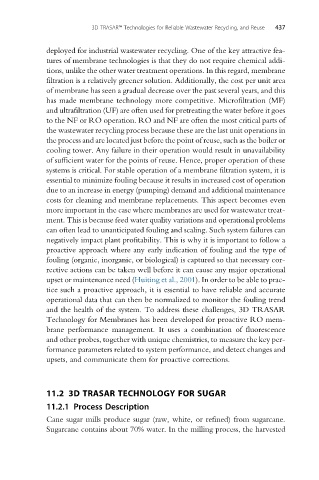Page 467 - Industrial Wastewater Treatment, Recycling and Reuse
P. 467
3D TRASAR™ Technologies for Reliable Wastewater Recycling, and Reuse 437
deployed for industrial wastewater recycling. One of the key attractive fea-
tures of membrane technologies is that they do not require chemical addi-
tions, unlike the other water treatment operations. In this regard, membrane
filtration is a relatively greener solution. Additionally, the cost per unit area
of membrane has seen a gradual decrease over the past several years, and this
has made membrane technology more competitive. Microfiltration (MF)
and ultrafiltration (UF) are often used for pretreating the water before it goes
to the NF or RO operation. RO and NF are often the most critical parts of
the wastewater recycling process because these are the last unit operations in
the process and are located just before the point of reuse, such as the boiler or
cooling tower. Any failure in their operation would result in unavailability
of sufficient water for the points of reuse. Hence, proper operation of these
systems is critical. For stable operation of a membrane filtration system, it is
essential to minimize fouling because it results in increased cost of operation
due to an increase in energy (pumping) demand and additional maintenance
costs for cleaning and membrane replacements. This aspect becomes even
more important in the case where membranes are used for wastewater treat-
ment. This is because feed water quality variations and operational problems
can often lead to unanticipated fouling and scaling. Such system failures can
negatively impact plant profitability. This is why it is important to follow a
proactive approach where any early indication of fouling and the type of
fouling (organic, inorganic, or biological) is captured so that necessary cor-
rective actions can be taken well before it can cause any major operational
upset or maintenance need (Huiting et al., 2001). In order to be able to prac-
tice such a proactive approach, it is essential to have reliable and accurate
operational data that can then be normalized to monitor the fouling trend
and the health of the system. To address these challenges, 3D TRASAR
Technology for Membranes has been developed for proactive RO mem-
brane performance management. It uses a combination of fluorescence
and other probes, together with unique chemistries, to measure the key per-
formance parameters related to system performance, and detect changes and
upsets, and communicate them for proactive corrections.
11.2 3D TRASAR TECHNOLOGY FOR SUGAR
11.2.1 Process Description
Cane sugar mills produce sugar (raw, white, or refined) from sugarcane.
Sugarcane contains about 70% water. In the milling process, the harvested

